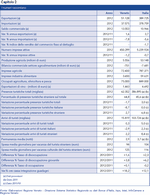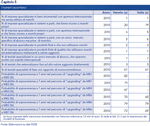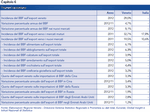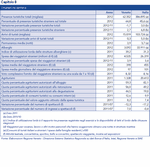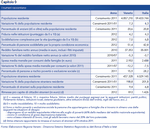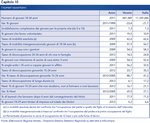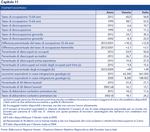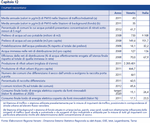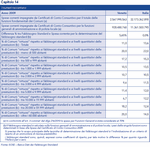Veneto in figures
Ongoing Distress
In 2012, the international economy improved slightly in the third quarter and global growth reached 3.2 % for the whole year. The main sources of acceleration were the emerging economies with a 5.1 % output increase, and among the advanced economies, only the United States, where GDP growth was 2.2 %. The moderate pace of international growth kept world trade trends subdued.The European Union ended its 2012 in a recession, -0.3 % to -0.6 % for the EU27 and the euro area. There wasa decreasing trend during the year, the EU showing a positive growth rate only in the first quarter and then negative for the remaining three quarters.
Italian economy has been going through great difficulties, where structural weaknesses have been exacerbated by an unfavourable economic situation. Over five years, it has had to cope with the financial crisis, the instability of the sovereign debt market, and two deep recessions. Since the crisis began, the Italian GDP has come down by 7 percentage points, and the number of the employed by 600,000 units.
2012 estimates show that Veneto has also been affected by the recession in a manner similar to the national level: the -1.9 % percentage variation of Veneto's GDP was slightly better than Italy's 2.4. The value added of services showed a stasis (-0.6 %), compared to -3.3 % for industry excluding construction, -5.6 % for construction, and a positive 0.5 % percentage variation for agriculture. As for the demand, we estimated a -4 % of household consumption and -8.5 % of investments.
2013 will be another year of stagnation that will then give way to recovery, which should start in 2014 with a growth at around 1.7 %.
Despite the economic difficulties, Veneto was the third wealth-producing region in Italy after Lombardy and Lazio: 9.4 % of Italy's Gross Domestic Product came from the Veneto region. Veneto's estimated per capita GDP in for 2012 was € 29,636, 15% higher than the national one.
However, we are still far from pre-crisis economic values. In real terms, Veneto's highest GDP value was achieved in 2007: 141.628 million euros that could become 132.769 million in the 2014 forecasts, which would mean going back to 2004 levels.
While still remaining above the Italian average, per capita GDP is expected to rise slightly in real terms in 2014 compared to 2013, recording however values like those of 1996, as many as 17 years earlier.
Economic Sectors and the Social Environment
Veneto's exports recorded in 2012 an increase of 1.6 % over the previous year, reaching a value of 51.1 billion euros. Export growth was supported by the increase in sales for markets outside the EU (+6.7 %), while exports to the EU area were down slightly (-1.9 %). In 2012, the negative trend in consumption was instantly reflected on commercial activities, causing Italy's 2012 retail sales to decrease overall by 1.7 % over the previous year.
In 2012, Veneto lost almost 2 businesses with physical headquarters out of 100 over the previous year; street trading ended the year slightly up compared to 2011 (+0.2 %), and the explosion of e-commerce continued, 16.8 % of 2012 sales.
The production value of the Veneto's agricultural sector in 2012 amounted to about 5.56 billion euro, a higher level than the previous year (+1.2 %).
A significant decrease in the trade deficit relative to agricultural and food products from the Veneto region was also observed in 2012. It decreased to € 751 million (-32 %) due to a significant increase in exports (+8 %), which reached € 4.82 billion, compared to the imports holding firm at 5.57 billion euro.
There was a significant increase in the number of workers employed in the agricultural sector (+7.5 %), which reached 75,000 units, while the food industry suffered a 1.6 % loss of employment, higher than the average for the whole industrial sector (-0.9 %).
Veneto's businesses followed the worsening national trend with regard to business survival during the past year: the private sectors in 2012 fell by 1.2 % of the volume of the previous year and 1.1 % of the preceding year, -1.1% if we exclude the agricultural sector.
The industrial sector continued to be affected by economic difficulties in 2012, -2.8 % for manufacturers and -3.5 % for construction companies. Businesses active in business services, hotels and restaurants and in the banking and finance industry continued to grow over the last three years; the economic downturn, however, determined a decrease of active trade (-0.9 % in 2012) and transportation (1.7 %) businesses.
In 2012, Veneto's tourism compared well with a record 2011, thanks to a stream of visitors amounting to 15.8 million arrivals (+0.3 %). Tourist attendance of 62.4 million (-1.7 % compared with the previous year) once again emphasized the trend toward reduction in guests staying for vacation.
After 2011, which had shown signs of recovery, during 2012 labour market difficulties became increasingly evident. In spite of this, Veneto kept its leadership by registering the fourth highest employment rate in Italy (65 %) and the second lowest unemployment rate, both overall (6.6 %) and for young people alone (23.7 %).
Changes to the Economic System
Economic systems are in constant evolution. Veneto's economic history was analyzed for the whole 1995-2011 time period and within its subsets: 1995-2000, fully positive years, 2000-2007, when the GDP started showing signs of instability, and finally 2007-2011, the years of the great crisis. Considering the entire 1995-2011 time period, Veneto's GDP grew on average by a yearly 0.9 % just as Italy's did. This result is due to the strong annual increase in the 1995-2000 years, which was equal to 2.4 % (1.9 % for the whole of Italy), bolstered especially by the exploit of 2000: the 2000/1999 percentage variation was equal to +5 %. In 2000-2007, the GDP grew by 1.3 %: after 2002's weak turnout, there was a good recovery especially in 2004, +2.7 %, up to the 2007/06 percentage variation of +2 %. Finally, the most recent 2007-2011 years marked a 1.4 % reduction of wealth: the 2009/2008 fall of 5.5 % had a strong negative impact on the whole time period.
Among the Italian regions, Veneto showed higher growth patterns throughout all time periods analyzed except during the crisis, when Veneto's fall was more intense than in other economically strong regions of the north, such as Lombardy and Emilia Romagna. This is explained by its economy being still strongly tied to manufacturing and international trade, sectors most affected by the global recession.
Our shift/share analysis shows that Veneto, like Lombardy, Emilia Romagna, Abruzzo, Marche, Piedmont, and Tuscany, was penalized by a structural composition characterized by a variety of activities in those sectors of the economy that proved to be less dynamic than others did within the reference period. Nevertheless, Veneto's value-added growth for the decade was only slightly lower than the national average, thus showing a positive local component, behind which lies a stable production system, capable of maintaining a relatively strong economic development level in the area compared to the national trend.
In terms of foreign sales, three regions contributed most to growth in these last twelve years, which explains the more than 55 % increase in national exports. These are Lombardy (27.7 %), Emilia Romagna (+16.4 %), and Veneto (+11.5 %).
In this time of history, research is a multiplier of productivity and as such, it is a key strategic lever to start the mature economies back towards recovery.
Veneto's research felt the effects of the crisis, but more than businesses, it was colleges and public institutions that cut activities deemed above minimum standards and therefore reduced spending on research. The impact of research spending on Veneto's 2010 GDP was equal to 1.04 %, slightly lower than in 2009 (1.08 %).
Businesses In Veneto: Processes of Change to Resist the Crisis
This chapter studies the bedrock of Veneto's businesses: those that stayed always active in the 2005-2010 time period, and had a structure of 10 employees and over. Our aim is to single out businesses of a size greater than micro that were able to maintain and even improve certain financial variables in recent years, such as turnover and profitability, in order to define their characteristics and perceive their strengths. By cross-referencing various statistical, administrative, and accounting archives, we obtained a ceiling of 16,729 businesses that were always active in the 2005-2010 time period, i.e., 66.6 % of all Veneto's businesses with more than 10 employees in 2010, which generally correspond to 77.4 % of total employment. Out of the businesses we analyzed, about 40% operated abroad in 2010, mostly for amounts under a million euros (23.3 %). It is however necessary to observe that operators exporting goods for more than 5 million euro covered 84.5 % of the total exports value in 2010.
Only 5.1% of the businesses analyzed invested in R&D; however, they covered over 75 % of Veneto's total private R&D expenditure in 2010.
The distribution by turnover category shows a strong concentration of businesses in the intermediate range: 10.8 % of businesses invoiced up to 1 million euros, 49.7 % invoiced in 2010 between 1 and 5 million euros, 28.4 % invoiced between 5 and 20 million euros, and the remaining 11.2 % exceeded 20 million euros in annual turnover.
It is comforting to note that the businesses in our set, analyzed in their entirety, recorded a profitability increase proportional to the increase in number of employees. The differentiation in business results seems to be a consequence of business size: where small businesses (10 to 19 employees) suffered in the 2005-2010 time period, recording negative average annual changes both in employment and in terms of profitability, medium-sized businesses tended to maintain their status, while the larger ones greatly improved. Businesses with a number of employees between 50 and 249 showed a mutual proportional growth in profitability and employment, while those with over 250 employees further enhanced employment numbers.
Our analysis definitely shows that the highest performing businesses were medium to large sized; they were almost 3,000 (20.7 % of the businesses we observed) and amounted for 66.6 % of all employees in our set of businesses (2010 data). The only small businesses that managed to emerge did so thanks to innovation and research investments.
Overall, businesses that engaged in research and development and operated abroad showed consistent improvement in profitability and good employment growth.
The Sector of Instrument Mechanics in the Veneto Region: How Can Businesses Change to Keep a Grip on the Market ?
This chapter presents further information for the Veneto territory about the results of a study directed at exploring in detail a few characteristics of the evolution of business models for Small and Medium Enterprises in the 'precision tools machinery 'sector on a national level. The large archive of SOSE structural data relating to enterprises with a turnover of less than 7.5 million Euros was used for this purpose.The term business model here refers to the combination of the main elements of the value chain through which the enterprises configure their activity and internal organisation in order to face competition; the particular way in which these are combined as a result of the decisions taken by each enterprise leads to a specific configuration of the activity that is synthetically reflected in a business profile.
In the second half of the two thousands (2004-2010), in the precision tool machinery sector in Veneto, the small enterprises demonstrated unstable competitive behaviour, being faced with continual changes on the economic scene, with the aim of strengthening the ability of remaining competitive in the market. In a few words, it can be said that both the adaptive behaviour (mainly the downgrading paths directed at simplifying the structure of the internal value chain and the consequent corporate organisation aspects) and the proactive paths (the adoption of more complex business models) have achieved this objective with considerable success. The probability of surviving on the market has in fact substantially increased for the businesses that have undertaken these transformation paths for their own business model, particularly in the short term (always above 90%) but also in the long term. On the other hand, the businesses that kept the same competitive approach stable and the same chain structure of internal value, without changing their 'value proposition,' generally met greater difficulties when attempting to remain on the market; the only exceptions being on the one hand, models with a market approach focussed on immaterial investments and managerial skills able to resist competition on the international markets and on the other hand, the model of 'exclusive' subcontracting towards a major client.
A Flywheel for Development: Veneto's Beautiful And Well-Made Goods in the New Markets
The so called 'Bello e Ben Fatto' (Beautiful and Well-Made, BBF hereinafter) indicates Made-in-Italy medium-high level goods from old and artisan traditions but which are innovative in terms of design and state-of-the-art technology. BBF are produced according to high quality and professional standards.With respect to the analysis presented in last year's Report, the field of observation of the medium-high level goods that make up Veneto BBF, aside from the food, clothing-home textiles, footwear and furniture sectors, also extends to include two sectors that are particularly important to the Veneto economy: eyewear and goldsmiths-jewellery.
BBF products represent an important leverage for the Veneto economy, and this is shown, in a situation of serious crisis of internal consumption, by the export figures: in 2012, with a growth of the overall exports equal to 1.6%, those of BBF increased by 4.7%; in 2012 they impacted on 29% of the overall Veneto exports. Moreover, that the growth opportunities have to be searched in other new-entry markets can be deduced also from the trend of BBF Veneto exports by destination area: in 2012, BBF exports increased by 8.1% in emerging countries and 4.7% in the developed ones.
Russia features among the most significant new markets in which Veneto is most active, particularly in the food, furniture and fashion sectors. This significant presence is favoured by the double consideration that, with respect to other emerging companies such as Brazil, China or India, in Russia, the medium class is in proportion more numerous and that the appeal that BBF products have on the new consumers of the country is strong.
Furthermore, beside Russia, there are other countries as important areas with high demand: firstly, China represents an opportunity to also access other Asiatic markets with high potential (for example India, Malaysia and Vietnam), which are more difficult to be approached directly. In China, considering the size of the market, Veneto BBF exerts a not insignificant impact; in eyewear and goldsmiths-jewellery in particular Veneto holds more than 20% share of the Chinese market.
Another market of great interest is represented by the United Arab Emirates, in which, with the exception of the eyewear, the impact of Veneto on the international demand of BBF is still relatively low: expansion margins are in fact expected again in all the sectors, thanks to the growth in appreciation of typical made-in-Italy products, spurred on also by tourism and trade-fair events.
Other markets offer growth prospects that are more directly linked to specific sectors of Veneto BBF: this is the case of Brazil for the food (wine, in particular) and of Mexico for eyewear and goldsmiths-jewellery
The Agricultural Sector amid Changes and Tradition
There are increasingly fewer agricultural holdings and these are on average becoming larger and larger with respect to the past. The average UAA has increased by over 40% just in the last ten years both in Veneto and in Italy, passing to 6.8 and 7.9 hectares respectively, while the number of both Veneto and Italian companies has fallen by 32.4%.In 2010, the sole proprietor holdings operated by land owners with exclusively owned land, of small dimensions and heavily centred on the family of the farm manager are still the most widespread form; moreover, half of the Veneto farm managers are more than 60 years old, the other profit-making activities connected to the farm are still little known and used: the arrival of young people in the agricultural world is bringing a strong transformation component and although the farm managers under 40 years old represent just 7% of the Veneto holdings, the impulse for renewal is considerably large.
Considering the agri-food exports (Nota 1) the performance of Veneto in comparison to that of Italy shows an almost double growth rate: looking at the last 20 years, while the Italian exports quadrupled (from 7.7 to 31.5 billion Euros), those of our region increased by almost seven times, from around 700 million Euros to almost 4.8 billion Euros, with sudden increases particularly in the periods 1992-95, 2005-2008 and 2009-2012.
From the point of view of the local market, where direct sale to the consumer has a great value, in Veneto just 8.3% of agricultural holdings resort to this trade channel, the second lowest in the country. The percentage of holdings that use other sales channels, such as those to commercial businesses (46%) or with associative organisations (42.9%) still remains decidedly predominant.
The Veneto fishing sector, finally, today is facing a profound transformation phase principally generated by a series of external factors that require the various supply chains to make structural adaptations as well as production evolutions: the fleet of Veneto fishing boats reflects the characteristics of artisan fishing, the age of the boats suggests a need for renewal.
From an economic/social point of view, the sector is distinguished by its marked entrepreneurial individuality and the increase in production costs, particularly those relating to energy. The excessive fragmentation and the substantial presence of micro-enterprises among the some 3,000 companies relating to fish and aquaculture, do not aid the re-launching of the fishing and entrepreneurial activities.
Transformation and Development of Tourism and Cultural Trends
The tourism sector, that in a period of economic difficulty continues to show record figures, once again confirming its importance in the regional economy, is continuously changing: in terms of demand, the tendency to replace long holiday periods with short breaks and weekends escapes from the city is evident. In terms of offer, the range of proposals is continually developing in order to meet the demands of an increasingly vast public: business tourism, the Veneto villas, the wine roads and regional products provide a few examples of this together with the "Year of Faith Itineraries," health tourism, cycle-tourism and fish tourism, so that Veneto is also facing the new challenge of widening the culture of hospitality that should be made available to everybody, including those having sensory impairments, health problems and mobility difficulties.As a reference point for European culture through the ages, today Italy focuses attention on the opportunity to integrate two large transformation policies: on the one hand, conserving the past and on the other, promoting innovation and therefore the production of the culture of the future. The conservation is not opposed to the development, but, on the contrary, represents one of the new faces of innovation for contemporary society, a long-term investment. The rediscovery and restoration of art works, the management of museums and historical towns and the recovery of the landscape are all important. Of equal importance is the enhancement of the many free and creative towns and villages, artistic traditions and much more, that creativity reinterprets and renews: from handicraft to gastronomy, from architecture to music and to literature. Culture means the development of creative activities not only to increase technological innovation, but also to improve the quality of life. At the same time, it is also a key to economic progress.
Strategies for the Family: Reviewing Priorities and Responses
Today undeniably represents a moment of changes, also of social nature: in the span of a few months, not only the general awareness of the details of the historical moment changed, but also the necessity and awareness of adjusting behaviour, life styles, personal and collective choices to fit the new situation.In 2011 took place the 15th Population and housing census that redesigned the demographic map of the country, highlighting the changes over the last ten years and providing replies not only to "how many are we" but also to "who are we" and "where and how" we are deciding to live. Decisions that more and more often are linked to work and income contingencies, but also to the social climate, the meeting of satisfaction with the present and hope for the future.
The worsening of the economic crisis caused a climate of distrust and general dissatisfaction to spread, affecting all the sections of the population, the areas of the country and the various social classes. The Italians, more than the Europeans declare to be worried by the economic-employment situation of the country and disappointed by the institutions, unhappy about the measures relating to the social inclusion and protection system, also wary of others.
Families which see their income decrease find themselves in increasing difficulty and in order to balance their books, they are often forced to use savings they had set aside. When this is not enough, they also have to make use of their assets. With the loss of the purchasing power, the level of consumption decreases and today the worse performance since 1997 is shown: the sacrifices are not always voluntary, concern extra expenditure items or leave the family status unaltered. However, if on the one hand the families find themselves facing sacrifices and limitations, on the other hand they demonstrate the ability to adapt themselves and differentiate with respect to the past goals and personal paths, also reinterpreting their vision of the world. Sobriety, need and rediscovery of a value, more careful and sustainable behaviour, also bringing consumption back to non-competitive logics which are not based on the status but on the need, thus eliminating waste and excesses considered normal in periods of economic growth.
The foreign presence, that in this crisis situation risks being seen in terms of conflict, is now considered in an ambivalent way, between excess and valid rights and recognitions. It is exactly the foreigners who acutely suffer the drama of growing unemployment that are however the most optimistic and share the increased general push towards personal commitment and the establishment of relations and combined networks.
The Energies of the Youth
Being young means growing and searching for a focus point on which to shape yourself, avoiding the threat of setbacks or at least trying to learn from these.Young people committed to the work of self-knowledge and the discovery of their own potential, are also citizens of a world that challenges them and also needs their contribution. Shifting interest from themselves towards others, for the wellbeing of the community, is an important indication of maturity for a young person approaching the adult age with a social awareness. Despite the general mistrust of institutions, young people continue to show an interest in their local area, most often undertaking voluntary responsibilities but still little involved in policy.
A society that wishes to evolve should be able to reflect on its generative capacity, i.e. whether it is investing in youngsters and knows how to enhance their potentiality and resources. If, on the one hand, the youngsters have a certain quality of life and social, cultural and relationship opportunities above those of their parents and have invested in training courses that ensure high levels of human capital, it seems that on the other hand they are coping with an uncertain future; let's consider that today the unemployment rate of young people is one of the highest in Europe.
Moreover, the opportunities for social mobility are lower in Italy than anywhere else: the close link to the family of origin remains strong, causing disparity in the opportunities of individuals. The youngsters seem to inherit privileges and disadvantages from their parents, the family background influences school decisions, the educational structures attended and therefore, the possibility of success in life.
The economic difficulties that are appearing throughout our country further complicate the achievement of total independence by young people. In order to be generative, it is necessary to know how to keep a safe distance from your family of origin. This allows you to truly become independent and make a personal contribution to society. The difficulties of flying the family nest relate to the complications of finding stability in working life, a source of uncertainty and precariousness in life projects, but also in the difficulties of sustaining accommodation costs. Many are still students, often unemployed, but there are also young people who are not employed, do not study nor are involved in training (Neet).
In this phase of economic change, today more than before, we are facing the prospect of going to live elsewhere, not so much as a temporary solution, but as a medium or long-term project.
However, youth remains the period of life in which abilities are put to the test and in which you experiment. Despite the difficulties in the laou market and in the achievement of independence, there are still people who invest in ideas and new forms of entrepreneurship. The future of young people, with challenges and success, also depends on the ability of the system to direct it towards entrepreneurship, cultivate enthusiasm, optimism and motivation for doing things alone and working with others.
Labour and Education: Challenges Old and New
From the establishment of the Kingdom of Italy through to today, our country has undergone many socio-economic changes with significant consequences on the labour market. The current level of Italian unemployment is the highest recorded this century and yet still remains relatively lower than that recorded at the end of the 80s and throughout the whole 90s. Then, the baby boom children were encountering many problems finding a job, people suffered due to the currency crisis of 1992 and women were increasingly interested in entering the labour market that was changing from an essentially industrial system to one mainly service-based.Many reforms have been introduced over the years and up until today. Italy was particularly boosted by the "Pacchetto Treu" (Treu Package) in 1997 and the "Biagi Law" in 2003, achieving an excellent performance in relation to the general lowering of the unemployment level. Excellent performances were indicated for our, region that from the end of the Nineties to the current economic crisis recorded even lower rates, falling from 6.4% in 1997 to 3.5% in 2008. Unfortunately, from autumn 2008 all the results achieved were thwarted by the crisis; despite this, in these difficult years Veneto confirmed itself as one of the leading regions and in 2012 recorded the fourth highest employment rate (65%) and the second lowest unemployment rate both in total (6.6%) and for just young people (23.7%). Vice versa, the employment rate of people aged 55-64 years grew everywhere. The ageing of the population is one of the main challenges of Italy and the European Union, which needs to be addressed in the coming years.
The enhancement of human capital is strictly connected to employment. Investing in more than just education means greater benefits for young people and their families and reduces the probability of them remaining excluded from the labour market, but it is also the basis for re-launching the economy of the country and moreover it drives development. People from the Veneto region are becoming increasingly educated: in 2012, 47.6% held at least a secondary-school diploma compared to just 35.4% in 2001. There are increasingly fewer children who leave school early, 14.2% compared to 18.1% in 2004 and the number of graduates aged 30-34 years increased from 16.1% in 2005 to 21.4%.
The Environment From the Global to the Local Dimension: the Ongoing Transformations
Among the factors characterising the surrounding environment, the air is one of the most important. In Veneto, there are some problems with the quality of the latter, especially linked to pollution such as particle matter (PM10) and ozone (O3). Their concentration in the atmosphere has fluctuated over time.Another factor connected to the environment is water. Veneto is rich in this natural resource: from lakes to rivers and from underground springs to the Adriatic sea. Overall, a good situation has emerged from the constant monitoring of the water quality and use of water sources in the region: most bathing waters fall under the quality category of 'excellent', and even waters destined for drinking do not present any issues, always maintaining very low nitrate concentration levels.
Waste is the third factor of absolute importance with regards to the environment. In Veneto, as in the rest of Italy, waste production still shows a growing trend. The only exception was in 2011, the last year of data available, which dropped compared to 2010, as a result of the economic crisis and the relative decline in consumption. However, a transformation of this sector is underway. Over a little more than a decade, separate waste collection has grown constantly, with a profound change in waste management systems: disposal in landfills reduced from 39% in 2001 to 8.2% in 2011, mainly in favour of the recovery of dry and organic fractions, which went from 19.5 to 33.4% and from 15 to 27%, respectively.
The last factor linked to the environment is energy, which is one of the main challenges for Europe. The main priorities are the reliability of supply, cost containment and respecting the environment by reducing greenhouse gas emissions. In this regard, Directive 2009/28/EC set forth a target, among others, which is aimed 20% of all consumption being covered by renewable resources before 2020 and each member state has to contribute to the extent appropriate to their means. A target of 17% was set for Italy which is shared between the regions for the heating/cooling sector and the electrical sector, pursuant to Ministerial Decree for Economic Development of 15/3/2012, known as the Burden Sharing decree. The general objective can be separated and identified from objective only concerning the electric sector which for Veneto is 15.1%, already reached and exceed in 2011 with a share of 17.1%.
Territorial Reorganisation and Associated Management
For some time, both at a national and a regional level, we have been following a road of reforms and transformations which will lead to a redesign of the entire territory with the aim of optimising public resources. The territorial reorganisation plan of the Veneto Region enters under this context, proceeding into two distinct, but related, directions, i.e. inter-municipal associations and simplification of the levels of government present in the territory. The territorial reorganisation plan should be based on homogenous areas identified by Regional Law 18/2012: the central area of Veneto, the lower area of Veneto, the area with high urbanisation and the mountain and partially mountainous areas. However, it also must consider the proposals made by the Municipalities, the already existing associations and the territorial contexts provided for by law.
With regards to the search for the optimal and homogenous territorial dimension for joint management, an analysis of the Veneto Municipal Administrations' budgets was carried out. On average, the Municipal Administrations incur a cost of 720 Euros per inhabitant. Going into further detail of the analysis of a homogenous area, it emerges that the central area of Veneto has a lower expenditure per capita (528 € per inhabitant), whilst the greatest expenditure is sustained by the provincial capitals (1,218 €) and the mountain and partially mountainous area (735 €).
Standard Needs: Efficiency and Equity in the Expenditure of Local Italian Authorities. A Focus on the Veneto Region
The enabling law on fiscal federalism (Italian Law 5 May 2009, no. 42) and the implementing provisions regarding the standard needs of local authorities (Municipalities, Provinces and Metropolitan Cities) issued with Italian Legislative Decree 26th November 2010 no. 216, offers Italy an important opportunity to modernise intergovernmental financial relations and improve the efficiency of the expenditure of local authorities. The reform process will allow equalising transfers to local authorities based on standard needs, abandoning the criteria of historic expenditure which is at the root of the inefficiencies in the distribution of intergovernmental transfers and the mismanagement of expenditure by local governments.This chapter illustrates the work carried out by SOSE S.p.A. during the two year period 2011-2012 and the development prospects forecast for 2013: it reports the financing amounts involved in the process of determining needs and summarises the results obtained during the two year period 2011-2012 relative to Veneto.
With regards to the general duties of administration and the local police, the Municipalities of the Region of Veneto show a standard need higher than historic expenditure by 5.65%; in simple terms, this can be seen as a sign of 'good' administration. In general, the small municipalities of Veneto, with a population up to 2,000 inhabitants show a lesser need on average compared to historic expenditure, whereas the municipalities of Veneto with over 3,000 inhabitants show a greater need on average with regards to historic expenditure. It should be noted that the small municipalities have significant diseconomies of scale.
The combined analysis of the differences between historic expenditure and standard need and actual output (historic output) and quantative levels of performance (standard output) gives rise to a map.
With regards to the general duties of administration and the local police, this positioning map of Veneto Municipalities concerning the standard needs and quantative levels of performance shows the following distribution of local Veneto authorities: 10% of municipalities are 'virtuous' as, faced with need lower than histroic expenditure, they provide a level of services higher than the standard; another 10% are 'above level' as the quantity of services supplied are higher than the standard, but they have a historic expenditure higher than the standard need; 60% of municpalities are 'below level' because, faced with a need higher than historic expenditure, they currently provide less services than their reference standard; finally, the remaining 20% are 'non-virtuous' as faced with historic expenditure higher than the need, they offer services below their reference standard, thus showing that there are large possibilities for improvement.











